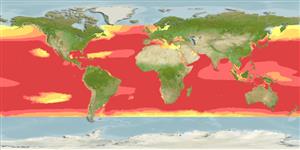Common names from other countries
分類 / Names
俗名 | 同種異名 | Catalog of Fishes(屬, 種) | ITIS | CoL | WoRMS | Cloffa
Teleostei >
Scombriformes (Mackerels)
鱸形目 (Mackerels) >
Scombridae (Mackerels, tunas, bonitos)
鯖科 (Mackerels, tunas, bonitos) > Scombrinae
Etymology: Thunnus: Greek, thynnos = tunna (Ref. 45335).
More on author: Bonnaterre.
Environment: milieu / climate zone / depth range / distribution range
生態學
海洋; 海洋洄游的 (Ref. 51243); 深度上下限 0 - 600 m (Ref. 168). 亞熱帶的; 10°C - 25°C (Ref. 168); 60°N - 50°S, 180°W - 180°E
Cosmopolitan in tropical and temperate waters of all oceans including the Mediterranean Sea but not at the surface between 10°N and 10°S. Western Pacific: range extend in a broad band between 40°N and 40°S (Ref. 9684). Often confused with juvenile Thunnus obesus which also have very long pectorals but with rounded tips. Highly migratory species.
全球分佈於熱帶與所有海洋包括地中海的溫帶水域但是不在水表面在 10 ° N 與 10個 ° S. 之間 西太平洋: 範圍延伸在 40 ° N 與 40個 °S 之間的一個寬的地帶中。 (參考文獻 9684) 經常與也有非常的 短鮪〔Thunnus obesus〕 的稚魚相混淆長的胸鰭但是有圓形的頂端。 高度遷移的種,1982年海事法會議的附件一.(參考文獻 26139)
Length at first maturity / 大小 / 重量 / 年齡
Maturity: Lm 85.2, range 83 - ? cm
Max length : 140 cm FL 雄魚/尚未辨別雌雄; (Ref. 3669); common length : 100.0 cm FL 雄魚/尚未辨別雌雄; (Ref. 9684); 最大體重: 60.3 kg (Ref. 40637); 最大年齡: 9 年 (Ref. 72462)
背棘 (總數): 11 - 14; 背的軟條 (總數): 12-16; 臀棘 0; 臀鰭軟條: 11 - 16. Anterior spines much higher than posterior spines giving the fin a strongly concave outline. Interpelvic process small and bifid. Body with very small scales. Pectoral fins remarkably long, about 30% of fork length or longer in 50 cm or longer fish. Ventral surface of liver striated and the central lobe is largest.
前面的棘比在後部的棘高許多給鰭一強烈地凹曲輪廓。 腹鰭間的突起小而兩裂的。 身體有最小鱗片。 胸鰭顯著長又大約 30% 的尾叉長或更長的在 50 公分或較長的魚中。 肝臟的腹面有條紋的與中央的葉大。
An epipelagic and mesopelagic, oceanic species, abundant in surface waters of 15.6° to 19.4°C; deeper swimming, large albacore are found in waters of 13.5° to 25.2°C; temperatures as low as 9.5°C may be tolerated for short periods (Ref. 168). Known to concentrate along thermal discontinuities (Ref. 168). Form mixed schools with skipjack tuna (Katsuwonus pelamis), yellowfin tuna (Thunnus albacares) and bluefin tuna (T. maccoyii), schools may be associated with floating objects, including sargassum weeds (Ref. 168). Feed on fishes, crustaceans and squids. Eggs and larvae are pelagic (Ref. 6769). Sexual maturity reached at 90 cm (Ref. 36731). Highly appreciated and marketed fresh, smoked, deep frozen or canned. Eaten steamed, broiled, fried and microwaved (Ref. 9987). Also Ref. 1762, 1798, 1804.
Angling: Largely caught offshore, where the waters are mild and blue. Albacore favor those areas where cooler water interfaces with warmer water. They are caught with live of dead baitfish such as mullet, sauries, squid, herring, anchovies, sardines, and other small fish. Albacore strike hard and make powerful runs (Ref. 84357).
一個表層帶與中層帶, 大洋性魚種, 豐富的在 15.6個 ° 的水表面中對 19.4 °C; 深處游泳又大的巴鰹魚被發現於對 25.2 °C 的 13.5個 ° 的水域; 溫度更低到 9.5 °C 可能是短暫地容忍.(參考文獻 168) 已知集中沿著躍溫層.(參考文獻 168) 具有鰹魚 ( 正鰹〔Katsuwonus pelamis〕 ) ,黃鰭鮪魚 ( 黃鰭鮪〔Thunnus albacares〕 ) 與藍鰭鮪魚 ( T. maccoyii) 的形式混合的魚群, 魚群可能是伴隨著漂浮的目標, 包括馬尾藻叢.(參考文獻 168) 捕食魚,甲殼動物與烏賊。 高度地欣賞了而且在市場上銷售生鮮、煙燻, 冷凍或罐裝的。 清蒸, 火烤, 油炸了而且微波了.(參考文獻 9987) 性成熟在 90 公分達到了。 (參考文獻 36731) 也參考文獻 1762,1798,1804.
Life cycle and mating behavior
成熟度 | 繁殖 | 產卵場 | 卵 | 孕卵數 | 仔魚
The sex ratio in catches is about 1:1 for immature individuals, but males predominate among mature fishes, which is possibly due to both differential mortality of sexes and differential growth rate after maturity. 全球分佈於熱帶與所有海洋包括地中海的溫帶水域但是不在水表面在 10 ° N 與 10個 ° S. 之間 西太平洋: 範圍延伸在 40 ° N 與 40個 °S 之間的一個寬的地帶中。 (參考文獻 9684) 經常與也有非常的 短鮪〔Thunnus obesus〕 的稚魚相混淆長的胸鰭但是有圓形的頂端。 高度遷移的種,1982年海事法會議的附件一.(參考文獻 26139)
Collette, B.B. and C.E. Nauen, 1983. FAO Species Catalogue. Vol. 2. Scombrids of the world. An annotated and illustrated catalogue of tunas, mackerels, bonitos and related species known to date. Rome: FAO. FAO Fish. Synop. 125(2):137 p. (Ref. 168)
CITES (Ref. 128078)
Not Evaluated
人類使用
漁業: 高經濟性; 游釣魚種: 是的
工具
特別的報告
下載 XML
網路資源
Estimates based on models
Preferred temperature (Ref.
115969): 8.8 - 21.2, mean 15.1 (based on 784 cells).
Phylogenetic diversity index (Ref.
82804): PD
50 = 0.5039 [Uniqueness, from 0.5 = low to 2.0 = high].
Bayesian length-weight: a=0.01738 (0.01428 - 0.02115), b=3.01 (2.97 - 3.05), in cm Total Length, based on LWR estimates for this species (Ref.
93245).
營養階層 (Ref.
69278): 4.3 ±0.2 se; based on diet studies.
回復力 (Ref.
120179): 中等的, 族群倍增時間最少 1.4 - 4.4年 (K=0.13-0.18; tm=4-6; tmax=10; Fec=2 million).
Prior r = 0.52, 95% CL = 0.34 - 0.78, Based on 7 stock assessments.
Fishing Vulnerability (Ref.
59153): High to very high vulnerability (71 of 100).
Climate Vulnerability (Ref.
125649): Moderate vulnerability (42 of 100).
